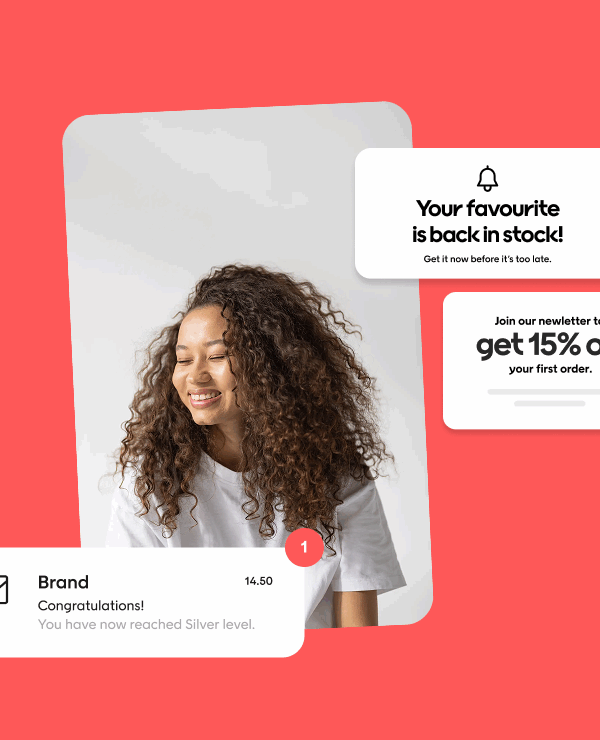TL;DR
- Retailers need retail omnichannel analytics to see how customers move between store and digital channels.
- The best tools connect POS, e-commerce, loyalty, and customer data so teams can act fast.
- Unified data improves customer experience, customer retention, and customer engagement across every step of the journey.
- Retailers that link analytics with activation grow faster than those stuck in data silos.
- Voyado helps teams connect insights with action across loyalty, customer experience, and omnichannel marketing.
You aim for one customer view, but your current stack keeps multiplying it into fifteen.
That is why many retail teams feel stuck. The data is there, but it sits across POS systems, e-commerce platforms, loyalty programs, mobile apps, and customer service tools.
Nothing lines up, and every team ends up working from a different picture.
This list gives you a fast way to see which platforms actually help you connect online and offline behavior. No jargon. No long detours. Just the tools that support real retail needs, from data integration to customer journey analytics to activation.
Let’s look at the top retail omnichannel analytics tools for 2026.
The 15 best retail omnichannel analytics tools for 2026
Retail teams want tools that help them understand customer behavior across physical stores, e-commerce, mobile apps, and loyalty touchpoints.
The tools below give you different ways to break down data silos, connect online and offline sources, and get actionable insights that support your omnichannel analytics strategy.
1. Voyado – Retail-native analytics tied to omnichannel activation
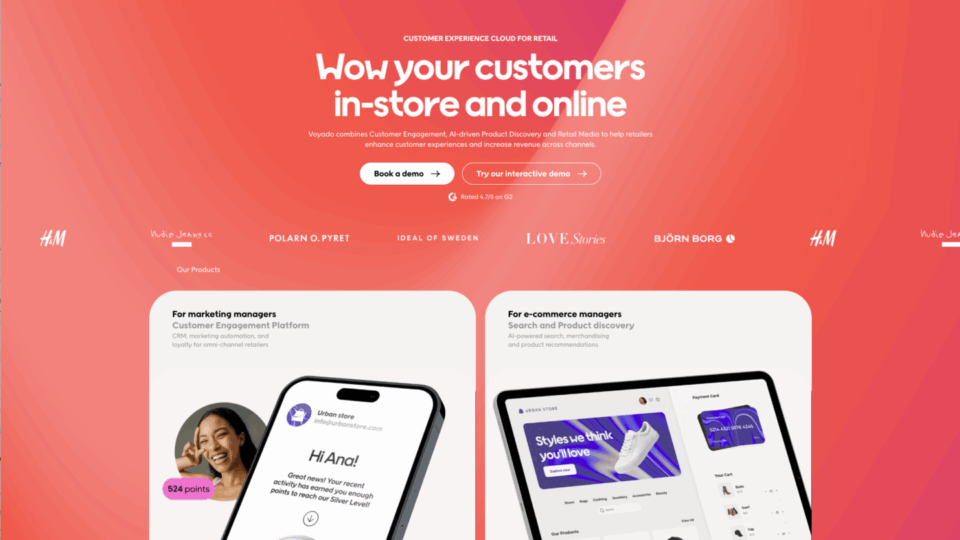
Voyado connects in-store activity, e-commerce behavior, loyalty data, and marketing interactions in one place.
It supports real retail omnichannel analytics and helps teams turn customer insights into real-time engagement across email, SMS, and on-site personalization.
Why it’s here:
- Unified profiles that link online and offline signals
- Journey analytics across multiple channels
- Activation is built directly into the platform
Standouts:
- Real-time triggers
- Loyalty impact analysis
- Retail dashboards
- Fast time to value
Best for: Retailers that want analytics, loyalty, and activation in one platform.
2. Adobe Customer Journey Analytics

Adobe Customer Journey Analytics helps large brands connect behavioral data across devices and channels so they can understand the full customer journey. It is part of Adobe Experience Cloud, which makes it strong for teams already using Adobe’s marketing stack.
Why it’s here:
- Connects cross-channel data for journey analysis
- Handles high data volumes and complex workflows
Standouts:
- Advanced visualizations
- Strong omni-device tracking
- AI-powered insights
Best for: Enterprises with advanced analytics resources.
3. Google Analytics 4 + BigQuery

Google Analytics 4 gives you event-based tracking for web and mobile, while BigQuery unlocks deeper analytics through a central data warehouse. Together, they help retailers analyze user behavior across digital touchpoints and build custom models.
Why it’s here:
- Event-based tracking across devices
- Scalable analysis through BigQuery
Standouts:
- Flexible data modeling
- Strong web and app insights
- Custom reporting options
Best for: Retailers with internal data engineering support.
4. Salesforce Data360
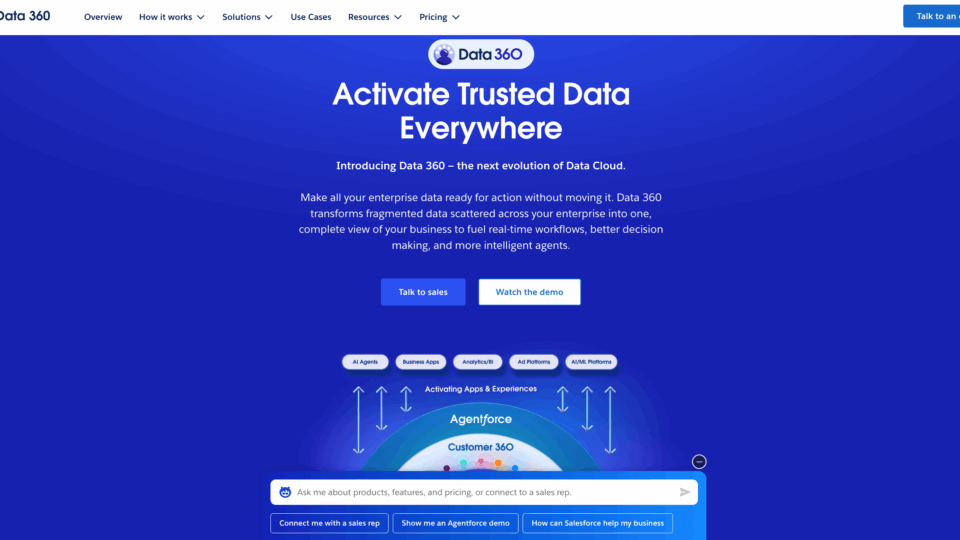
Salesforce Data360 brings together data from CRM systems, service platforms, commerce tools, and external sources to create unified customer profiles. It works well for teams that already use Salesforce products.
Why it’s here:
- Strong profile unification
- Real-time data updates
Standouts:
- Deep Salesforce integrations
- Activation through Marketing Cloud
- Broad data ingestion options
Best for: Salesforce-centric retail organizations.
5. Microsoft Dynamics 365 Customer Insights
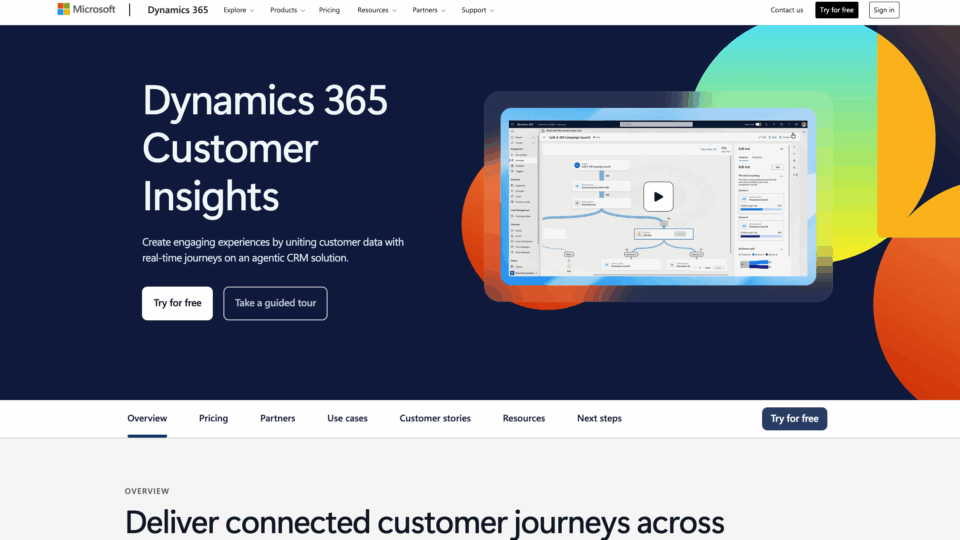
Dynamics 365 Customer Insights unifies data from commerce, CRM, ERP, and social sources to create a complete customer view. It supports personalized marketing and helps teams improve customer experience across store and digital channels.
Why it’s here:
- Full customer profiles across data sources
- AI-driven insights and segmentation
Standouts:
- Predictive scoring
- Channel personalization
- Operational integrations
Best for: Retailers already using Microsoft’s business applications.
6. Amperity
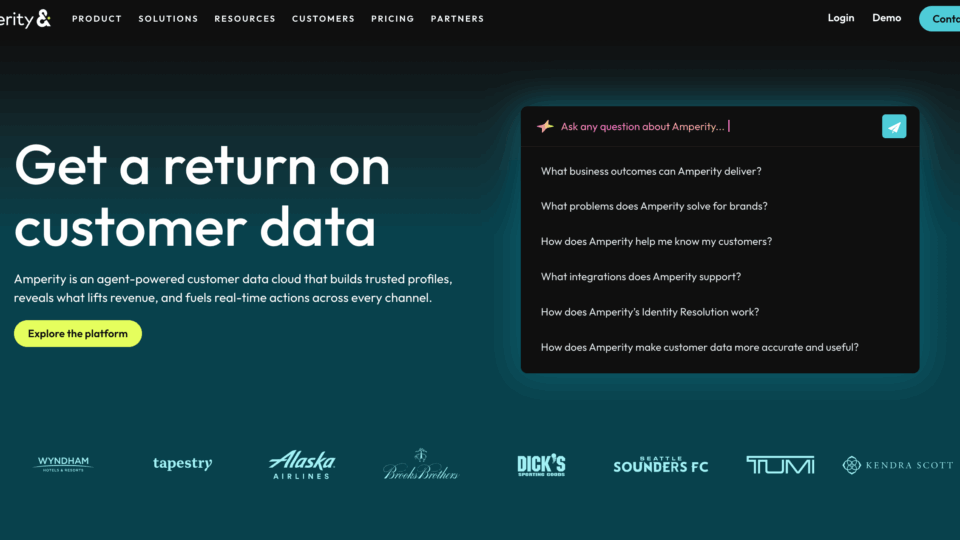
Amperity uses AI to help brands unify fragmented customer data and resolve identities across online and offline sources. It supports a full view of customer behavior and provides data-driven actionable insights for retail analytics.
Why it’s here:
- Strong identity resolution for multiple channels and devices
- Builds unified customer profiles that power segmentation and activation
Standouts:
- AI-powered identity stitching
- Data warehouse integrations
- Marketing activation built in
Best for: Retailers with complex data sources needing strong identity and segmentation.
7. Twilio Segment
Twilio Segment is a CDP that centralizes data from web, mobile, and offline systems so you can analyze the full customer journey and activate insights across channels.
Why it’s here:
- Collects and unifies customer data across touchpoints and devices
- Enables actionable insights and real-time audience activation
Standouts:
- 700+ integrations
- Real-time audience builder for cross-channel campaigns
- Strong privacy and data governance controls
Best for: Retailers focusing on data quality and cross-channel customer engagement.
8. Tealium
Tealium works as a customer data platform and tag management system that helps retailers bring together online, mobile, and in-store data. It supports unified customer views and data activation across channels.
Why it’s here:
- Focus on data orchestration and governance across marketing, app, and store systems
- Enables retailers to integrate multiple sources and activate data in real time
Standouts:
- Unified customer data hub
- Strong capabilities for managing data across multiple device owners and channels
- Good fit for omnichannel data analytics strategy
Best for: Retailers that want streamlined data collection and governance across online and physical channels.
9. Bloomreach Engagement
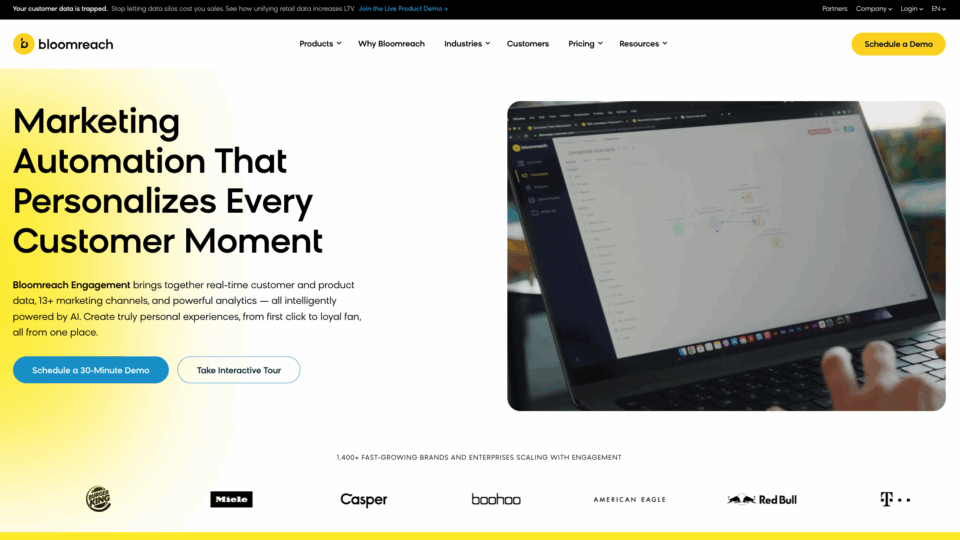
Bloomreach Engagement is built for e-commerce and B2C retailers; it combines customer data, analytics, and activation tools so you can optimise the whole journey from web to store.
Why it’s here:
- Brings together web analytics, segmentation, and activation for customer engagement
- Supports omni-device and multi-channel campaigns with unified data
Standouts:
- E-commerce-centric analytics platform
- Built-in personalization and campaign execution
- Focuses on turning analytics into actionable marketing efforts
Best for: Retailers looking for a tool that links analytics with marketing campaigns and loyalty.
10. SAP Emarsys

SAP Emarsys is a marketing automation and customer engagement platform that includes analytics and cross-channel insights. For retailers, it offers a way to link customer behavior across store, web, email, mobile, and campaigns.
Why it’s here:
- Enables analysis of customer interactions across multiple channels and devices
- Integrates with POS and e-commerce systems to support full customer journey analytics
Standouts:
- Cross-channel marketing analytics are built into the platform
- Segmentation and personalisation for retail-specific scenarios
- Actionable analytics tied to marketing automation
Best for: Retail teams that want insights and activation in one tool with a strong marketing emphasis.
11. Mixpanel
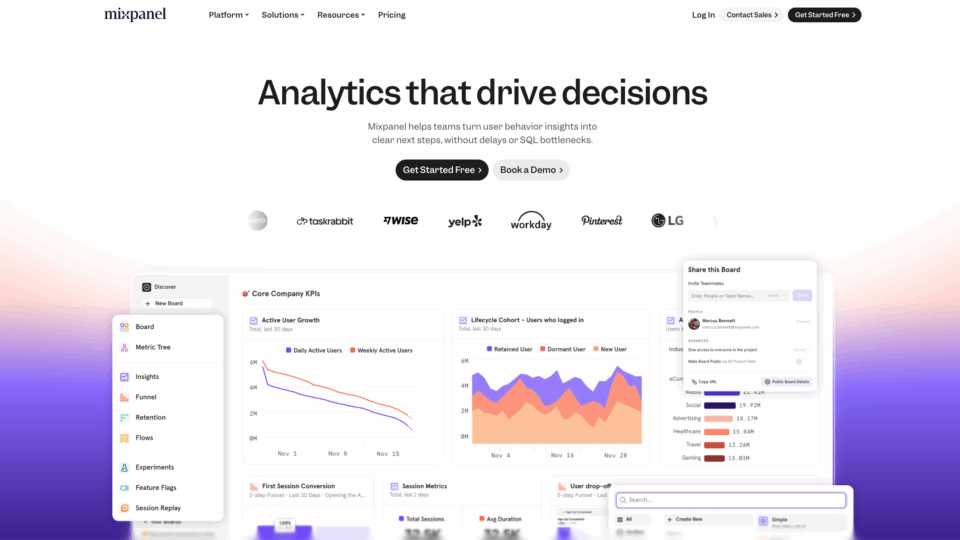
Mixpanel helps teams analyze customer behavior across apps, websites, and digital journeys. It gives retailers a clear view of user actions so they can understand customer interactions and improve customer engagement across different marketing channels.
Why it’s here:
- Strong event analytics for understanding user behavior and customer journeys
- Helps teams see which touchpoints drive conversions and customer satisfaction
Standouts:
- Fast, self-serve reports
- Clear funnels and retention analytics
- Good for analyzing data at scale
Best for: Retailers focusing on digital behavior and customer journey analytics.
12. Piwik PRO
Piwik PRO offers privacy-focused analytics for retailers that need full control over customer data. It supports data collection from online and offline sources while helping teams meet strict compliance requirements.
Why it’s here:
- Strong data governance for customer analytics and sensitive data sources
- Helps retailers build a unified customer view without third-party tracking concerns
Standouts:
- On-premise and cloud hosting options
- Detailed customer behavior analytics
- Strong privacy and consent controls
Best for: Retailers with strict privacy, data residency, or compliance needs.
13. Woopra
Woopra tracks customer interactions across websites, apps, emails, and support channels so retailers can see the entire customer journey in one analytics platform.
Why it’s here:
- Connects multiple data sources for end-to-end customer journey analytics
- Helps teams understand customer pain points and improve customer engagement strategies
Standouts:
- Real-time customer profiles
- Journey mapping
- Strong integrations with CRM systems and marketing tools
Best for: Retail teams that want a simple, unified view of how customers interact across channels.
14. Placer.ai
Placer.ai provides foot traffic insights and location analytics so retailers can understand how customers behave in and around physical stores. It turns real-world movement into actionable insights that support omnichannel strategies.
Why it’s here:
- Measures store visits, dwell time, trade areas, and cross-shopping behavior
- Helps teams connect offline customer behavior to marketing performance
Standouts:
- Industry-leading retail location data
- Strong benchmarking tools
- High accuracy for physical store analytics
Best for: Retailers with large store footprints or those optimizing store operations and merchandising.
15. Improvado

Improvado centralizes marketing data from hundreds of channels so retail teams can analyze marketing performance, customer behavior, and revenue influence in one place.
Why it’s here:
- Brings together data from marketing channels, ads, social media, and CRM systems
- Helps teams eliminate data silos and improve reporting efficiency
Standouts:
- Customizable dashboards
- Automated data integration
- Strong focus on marketing analytics and operational efficiency
Best for: Retailers that want an easy way to unify marketing data without heavy engineering work.
These fifteen tools give retail teams different ways to understand customer behavior across online and offline sources.
Some focus on identity and customer data. Others specialize in journey analytics, foot traffic insights, or marketing performance.
The right choice depends on your data sources, your goals, and how quickly you want to turn customer insights into action.
Voyado stands out because it links retail omnichannel analytics with loyalty, segmentation, and activation in one place.
Other tools offer strong analytics or strong engagement features, but Voyado brings both together for a faster path to value.
What actually makes a strong omnichannel analytics platform? Here’s how we assessed these tools:
How we evaluated these tools
Retailers need tools that make customer behavior easy to understand, not harder. We kept the criteria simple and focused on what actually helps teams work faster.
The essentials at a glance
| What we looked for | Why it matters | What it tells you |
| Data coverage | Your data comes from everywhere | Can the tool join store, e-commerce, app, and loyalty data |
| Identity resolution | One customer view is everything | Can it match devices, guests, and households |
| Speed | Retail decisions move fast | How long it takes to turn an event into an action |
A few other things that make a big difference
- Can it bring in receipts, store visits, and returns without extra work
- Does it offer retail-ready dashboards you do not have to build from scratch
- How accurate the attribution is when customers switch channels
- How fast you can get value without long setup or heavy services
- Whether privacy tools are built in, not bolted on
And yes, cost matters too
We looked at the full price, including setup, services, and ongoing support. Retailers need tools that give value fast, not ones that take months to pay off.
A tool can look great on paper, but what matters is how well it fits your day-to-day retail work. The right platform should make your life easier, not add another layer of complexity.
That is where a quick vendor-fit checklist helps. It shows you what to look for before you commit to any platform. Let’s walk through the essentials.
Vendor-fit: Your 10-question checklist
Choosing the right platform is much easier when you know what matters for retail omnichannel analytics.
Use the questions in this checklist to see which tools actually support your customer journey and which ones will slow you down.
1. Does it connect your core data sources?
You need a tool that joins POS, e-commerce, mobile apps, loyalty, and customer service records without extra work.
If it cannot bring customer data from online and offline sources together, it will limit your omnichannel analytics.
2. Can it create a unified customer view?
Strong identity resolution helps you match devices, guests, and households. This is key for omnichannel retail analytics, customer behavior insights, and any full customer journey analysis.
3. How fast is event-to-action latency?
Retail moves fast. A good platform can react to real user demand with real-time triggers, segmentation updates, and actionable insights.
Slow systems make it harder to support omnichannel marketing analytics and customer engagement.
4. Does it support real attribution?
Look for tools that offer incrementality, holdouts, and cross-channel attribution. This helps you understand what is actually working across marketing channels and touchpoints.
5. Are the dashboards retail-ready?
You should not have to build everything yourself. Prebuilt dashboards for stores, digital teams, and CRM save time and improve operational efficiency.
6. Does it make sense for your omnichannel strategy?
If you are still comparing omnichannel e-commerce strategy with multi-channel setups, remember that the right tool should support both your data integration work and your long-term customer engagement strategies.
7. Is the setup simple and fast?
Time matters. Look for connectors, clean data models, and templates that reduce the work required to get insights.
Slow onboarding leads to slow business impact.
8. Will it scale with your marketing efforts?
As your customer segments grow and new data sources appear, the platform should keep up.
Large retail teams often need advanced customer analytics and predictive analytics, not just basic reporting.
9. Does it support privacy and governance?
Privacy tools should be built in, not an afterthought. This becomes more important as more customer data platforms enter the stack.
10. Does it help you see store behavior?
If stores matter, you need a tool that supports location insights or blends smoothly with tools like retail location analytics.
A checklist only works if it helps you see what actually matters. When you look at your tools through this lens, it becomes clear which platforms support your omnichannel strategy and which ones create more data silos than they solve.
Now, all that’s left is for you to find the tool that best fits your business and team.
Over to you: How to move forward with clarity and confidence
Retail omnichannel analytics only works when your teams can see one customer journey and act on it fast.
The right platform should help you unify customer data, understand customer behavior, and improve every step of the journey without adding more work to your day.
Your next steps
- Review where your customer data sits today and note any data silos
- Map your online and offline touchpoints to see where the journey breaks
- Choose which customer insights matter most for your team right now
- Compare your top tool options against the vendor-fit checklist
- Focus on platforms that help you go from insight to action without complexity
When you apply these steps, it becomes much easier to find a platform that supports real customer engagement and a stronger omnichannel strategy.
If you want analytics and activation in one place, Voyado gives you unified profiles, journey insights, and real-time engagement built for retail.
See how Voyado connects analytics to action. Book a demo.
FAQs
What is omnichannel analytics?
Omnichannel analytics helps you understand customer behavior across online and offline sources.
It brings together customer data from your POS, e-commerce store, mobile apps, and loyalty program so you can improve the full customer journey and reduce data silos.
This is the foundation of any strong omnichannel strategy.
What is the difference between omnichannel and multichannel retailing?
If you are comparing omnichannel vs multichannel retailing, the key difference is how data flows. Multichannel keeps everything separate.
Omnichannel creates one connected experience, which supports better omnichannel retail analytics and a unified customer view.
Why is omnichannel important for retail?
Many teams still ask why omnichannel is important when their systems do not work together. Omnichannel strategies help you understand the customer journey, improve customer engagement, and build experiences that feel personal across every touchpoint.
How does omnichannel data analytics support decision-making?
Strong omnichannel data analytics gives you actionable insights into customer preferences, customer pain points, and channel performance.
It helps you understand where customers drop off, what influences customer lifetime value, and how to improve your marketing efforts.
How does omnichannel retailing help you unify customer data?
Omnichannel retailing joins store data, e-commerce data, and loyalty activity so you can see one customer journey instead of separate touchpoints.
It also supports better omnichannel marketing analytics, stronger customer insights, and more accurate segmentation.





